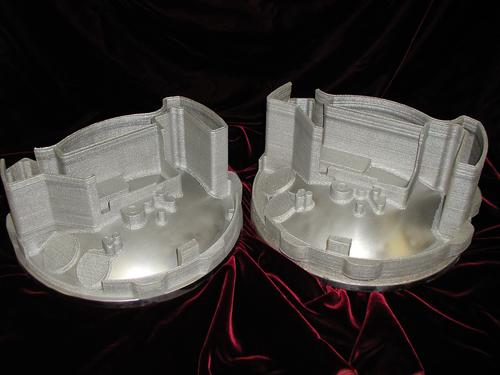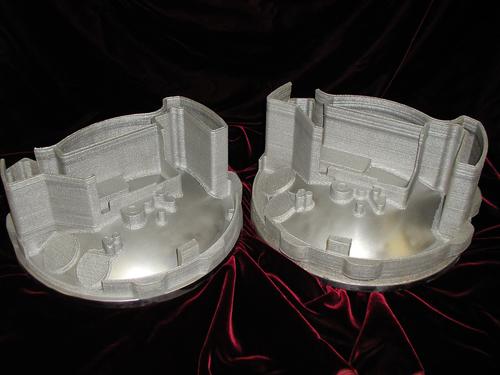June 8, 2015

It's possible to integrate both additive and subtractive manufacturing processes in one system to make a single part. There's more than one way to do this, and I saw several at the recent RAPID 2015 show in Long Beach, Calif. Today I'll tell you about the system that's the result of an America Makes project spearheaded by Optomec for making structural metal parts, and for less than it used to cost.
The company is involved in three different America Makes projects using its LENS metal additive manufacturing (AM) technology, used for many years in military and aerospace applications for low-volume manufacturing and in-service product repair. One project that's almost finished is the development of a low-cost LENS print engine that can be installed on most machine tools to form a hybrid system. The project's main goal is to speed up the use of metal AM in US industry. At RAPID I met with Optomec's vice president of marketing, Ken Vartanian, who filled me in on the details.
The LENS process, developed by Sandia National Labs, is based on metal laser deposition, but it's not a powder bed system. Instead, it uses blown powders, commonly engineering alloys such as stainless steels, tool steels, titanium alloys, and cobalt alloys. These are continuously blown through nozzles directed at the focal point of a high-powered laser. Other versions of blown powder use a different heat source such as electron beam. In all of them, the resulting pool of molten metal is moved using a motion control system, while the part is built up in open space, so much larger parts can be built than is possible in powder bed systems.
MORE FROM DESIGN NEWS: 3D Printing Using Powder Metals: Choosing the Right Process for the Right Application
Optomec's process can add metal onto existing substrates that aren't flat: they can be almost any shape, so the technology is used for ground-based defense and non-defense repairs. Some manufacturers already combine AM with subtractive methods to take advantage of what each process does best. For example, the ability of AM processes to deposit material only where its required reduces waste, especially important when using higher-value materials such as titanium and super alloys.
The America Makes project has resulted in a relatively low-cost modular engine that's easy to upgrade and maintain as part of a machine tool system. The hybrid system created by merging the two can drastically reduce the amount of time it takes to machine parts, said Vartanian. The project incorporates controls, toolpath generation, and quality monitoring. The other partners included Lockheed Martin and the US Army Benet Laboratories as technical advisors, MachMotion for the integrated additive/subtractive controller, and TechSolve for hybrid process validation and optimization.

America Makes and some of the partners unveiled the result the week before RAPID 2015 at an event in Cincinnati, Ohio. Optomec's LENS print engine was integrated with a legacy 1990s Fadal Vertical Mill CNC machine so both additive and subtractive processes can be performed on the same metal part. You can access a presentation given at the event here and a FAQ on the hybrid system here. A second LENS print engine has been integrated with another Fadal Vertical Mill CNC machine, which is being installed at the Golisano Institute for Sustainabilityat the Rochester Institute of Technology in Rochester, NY.
The hybrid system maintains its full CNC machining capabilities while the LENS print head is in the idle position. For rapid prototyping, metal parts can be 3D printed while the cutting tool is idle. Because printing and finishing can be done in one setup, the team estimates that materials costs can be cut 90% or more. Manufacturing time can be shaved even more drastically. In one case, the time needed to build a stainless-steel electronic housing went from 52 weeks for an entirely cast part to only three weeks, a 94% reduction, when the base housing was machined and vertical walls were 3D printed on it using the LENS print head. In addition, Vartanian said, design changes could be made during the development process.
MORE FROM DESIGN NEWS: 3D-Printed Working Motorcycle Demonstrates What The Tech Can Do
The print engine contains only the core LENS technology, and hasn't yet been integrated with all CNC machines. Pricing depends on which elements of the solution customers already own and whether they have in-house integration capability, said Vartanian. For those who already own the laser and their own machine tool base, and who know how to do the necessary integration, Optomec will sell the LENS deposition head and powder feeder combined for $110,000. At the other extreme, if Optomec sources the laser and the machine tool base, performs the integration and makes sure the controller will do both AM and subtractive processes correctly, the cost is about $500,000. That's compared to $1 million for full-on metal AM standalone systems, or even more for some of the new hybrid systems.
Ann R. Thryft is senior technical editor, materials & assembly, for Design News. She's been writing about manufacturing- and electronics-related technologies for 27 years, covering manufacturing materials & processes, alternative energy, and robotics. In the past, she's also written about machine vision and all kinds of communications.
Atlantic Design & Manufacturing, the largest advanced design and manufacturing trade show serving the Northeastern US, will take place in New York, June 9-11, 2015. It's your chance to meet qualified suppliers, get hands-on with the latest technologies, and expand your network. Learn more here.
About the Author(s)
You May Also Like



